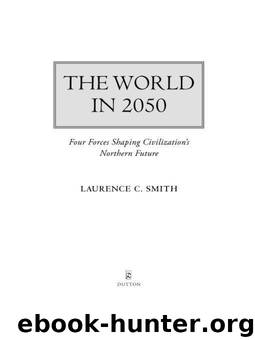The World in 2050: Four Forces Shaping Civilization's Northern Future by Laurence C. Smith

Author:Laurence C. Smith
Language: eng
Format: mobi, epub
Tags: Science
Publisher: Dutton
Published: 2010-09-22T15:00:00+00:00
Contrasting Patterns of Settlement
The decision of Soviet planners to relocate millions of people and force the growth of giant cities across her coldest, most remote terrain has created one of the most fascinating contrasts in human settlement found on Earth.
On a world map or globe Norway, Sweden, and Finland look coldest of all. Their settlements and infrastructure are arranged in a north-south direction and extend even farther north than most Siberian cities. But don’t be fooled. They are bathed in heat from the North Atlantic Current and enjoy much warmer winters than Russia, even high above the Arctic Circle. I once visited Norway’s lovely city of Tromsø, at 70° N latitude, in January, its coldest month of the year. Its residents were out in force, romping in the snow and chatting amiably in their front yards. Even in January the average daytime temperature is +25°F in Tromsø, warmer than Minneapolis. Reykjavík, the capital of Iceland, which is plunked squarely in the warm current, averages a balmy +35°F. But in Russia’s Novosibirsk, way down south at 55° N latitude, temperatures are subzero, averaging -2°F. Worry not for the Nordics.
Returning to our world map or globe, Canada and Russia at first look rather similar. Both are enormous countries with long east-west coastlines fronting the Arctic Ocean. Both have vast emptiness in the northern parts of their bulk. Both have a band of cities also running in an east-west direction, just north of and roughly parallel to their long southern borders.
But upon closer inspection some differences emerge. Canadian cities hug the U.S. border like a long spotted eel, whereas Russian cities are arranged more like a shotgun blast. Owing to the peculiar orientation of Russia’s climatic gradient (recall that in Canada, temperatures grow coldest moving from south to north, but in Siberia from west to east), Russian cities, unlike Canada’s, push deeply into the coldest parts of the country. It is roughly analogous to Canada establishing her population centers in a band of huge cities running from south to north, from the U.S. border all the way to the Arctic Ocean.
Under the Soviet planned economy, metropolises were grown in places that don’t make sense: in harsh cold, separated from one another and from potential international trading partners by great distances. They are precariously linked by absurdly stretched infrastructure, if even linked at all. Their subsidization so saddled the Soviet economy that some researchers believe they helped bring about the collapse of the USSR in 1991.402 Afterward, of course, the subsidies evaporated and in the 1990s the giant Siberian cities depopulated faster than Detroit in a bad layoff year. In eastern Siberia the population fell by half—from about twelve million to six—a free fall that is only now stabilizing as the region’s population downsizes to some semblance of a free-market equilibrium economy. But even after this depopulation, the Russian Federation is unique among the NORCs in having so many big cities in its coldest, most remote territories.
Perhaps one day, having far-flung urban cores and disseminated infrastructure throughout the New North will pay off.
Download
The World in 2050: Four Forces Shaping Civilization's Northern Future by Laurence C. Smith.mobi
The World in 2050: Four Forces Shaping Civilization's Northern Future by Laurence C. Smith.epub
This site does not store any files on its server. We only index and link to content provided by other sites. Please contact the content providers to delete copyright contents if any and email us, we'll remove relevant links or contents immediately.
How to Do Nothing by Jenny Odell(2680)
A Forest Journey by John Perlin(2620)
The Plant Messiah by Carlos Magdalena(2484)
Babylon's Ark by Lawrence Anthony(2100)
Energy Myths and Realities by Vaclav Smil(2091)
The ESV Study Bible by Crossway Bibles(2055)
Abbey in America by Murray John A(1826)
Fatal Storm by Rob Mundle(1810)
Witness Tree by Lynda V. Mapes(1709)
Shadows on the Gulf by Rowan Jacobsen(1536)
Client Earth by James Thornton(1522)
Brokeback Mountain by Annie Proulx(1492)
Coming Back to Life by Joanna Macy(1485)
Water Rights and the Environment in the United States by John Burch(1430)
Cosmos by Carl Sagan(1422)
Ten Billion by Stephen Emmott(1401)
Mycelium Running: How Mushrooms Can Help Save the World by Paul Stamets(1315)
The overachievers by Robbins Alexandra(1298)
The Uninhabitable Earth by David Wallace-Wells;(1209)
